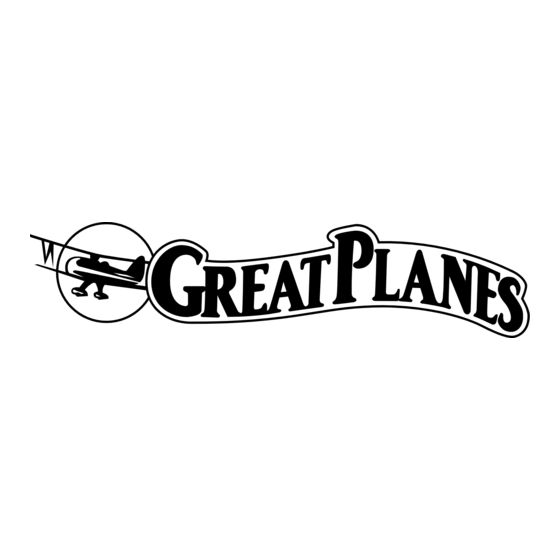GREAT PLANES synapse arf Instruction Manual - Page 12
Browse online or download pdf Instruction Manual for Toy GREAT PLANES synapse arf. GREAT PLANES synapse arf 12 pages.

❏
1. Check the C.G. according to the measurements
provided in the manual.
❏
2. Be certain the battery and receiver are securely
mounted in the fuse.
❏
3. Confi rm that all controls operate in the correct direction
and the throws are set up according to the manual.
❏
4. Check the operation of the ducted fan unit prior to
each fl ight.
❏
5. Make sure that all servo arms are secured to the servos
with the screws included with your radio.
❏
6. Place your name, address, AMA number and telephone
number on or inside your model.
❏
7. If you wish to photograph your model, do so before your
fi rst fl ight.
❏
8. Range check your radio when you get to the fl ying fi eld.
IMPORTANT: If you are an inexperienced modeler we
strongly urge you to seek the assistance of a competent,
experienced R/C pilot to check your model for airworthiness
AND to teach you how to fl y. No matter how stable or
"forgiving" the Synapse is, attempting to learn to fl y on your
own is dangerous and may result in destruction of your
model or even injury to yourself and others. Therefore, fi nd
an instructor and fl y only under his or her guidance and
supervision until you have acquired the skills necessary for
safe and fully controlled operation of your model.
We recommend fl ying the Synapse EDF ARF when the wind
is no greater than 16 kmph [10 mph]. Less-experienced
fl yers should fl y the Synapse only in calm (less than fi ve
mile per hour) conditions. Frequently, winds are calm in the
early morning and early evening. Often these are the most
enjoyable times to fl y anyway!
Until you have the Synapse properly trimmed for level fl ight,
we recommend having an assistant hand-launch the model
instead of launching it yourself.
Turn on the transmitter and plug the battery into the speed
control. Turn on the receiver by following the instructions
that came with your speed control. Secure the canopy hatch
in place.
IMPORTANT:
Confi rm that the transmitter operates the
controls properly by moving the sticks and watching the
surfaces respond.
When ready to launch, the assistant should hold the Synapse
by the fi nger grips in the lower duct channel half, with the
model in front of him and pointed into the wind. With the pilot
(that would be you!) standing behind the plane, fully advance
the throttle to start the motor. When the motor is at full power,
FLYING
Launch
the hand launcher should gently give the model a toss into
the air with a slightly nose-up attitude. Be certain the model
is being launched into the wind and be immediately ready to
make corrections to keep the airplane fl ying straight, level
and into the wind.
When the model has gained adequate fl ying speed under
its own power, gently pull the elevator stick back until the
airplane starts a gradual climb. Many beginners tend to pull
too hard causing the model to stall, so be gentle on the
elevator and don't panic. If you do pull too hard and you
notice the model losing speed, release the elevator stick and
allow the model to regain airspeed.
Continue a gradual climb and establish a gentle turn (away
from yourself and others) until the airplane reaches an
altitude of 20 to 30 meters [75 to 100 feet].
The main purpose of the fi rst few fl ights is to learn how the
model behaves and to adjust the trims for level fl ight. After the
model has climbed to a safe altitude, reduce the throttle slightly
to slow the model, yet maintain altitude. The Synapse should fl y
well and maintain adequate airspeed at about 1/4-1/2 throttle.
Adjust the elevator trim so the model fl ies level at the throttle
setting you are using. Adjust the aileron trim to level the wings.
It may take a few minutes to get the trims adjusted, but this
should be your fi rst priority once at a comfortable altitude.
Continue to fl y around, executing turns and making mental
notes (or having your assistant take notes for you) of what
additional adjustments or C.G. changes may be required to
fi ne tune the model so it fl ies the way you like.
Begin the landing approach by fl ying downwind at an altitude
of approximately 6 meters [20 feet]. When the airplane is
approximately 15 to 30 meters [50 to 100 feet] past you,
gradually reduce power and make the "fi nal" 180° turn into
the wind aligning the airplane with the runway or landing
area. Do not dive the airplane, as it will pick up too much
speed. Instead, allow the airplane to establish a gradual
descent. Concentrate on keeping it heading into the wind
toward the runway. When the plane reaches an altitude of
about 3 feet [1 meter], gently apply a little "up elevator" to
level the plane, but be careful as too much up elevator will
cause it to stall. While holding a slight amount of up elevator
the airplane will slow and descend as it loses fl ying speed,
thus touching-down on the runway.
Until you are able to accurately judge how far the Synapse
can glide, it may be helpful to reserve some battery power to
run the motor so the plane can be fl own back to the runway.
Best of luck and happy fl ying!
